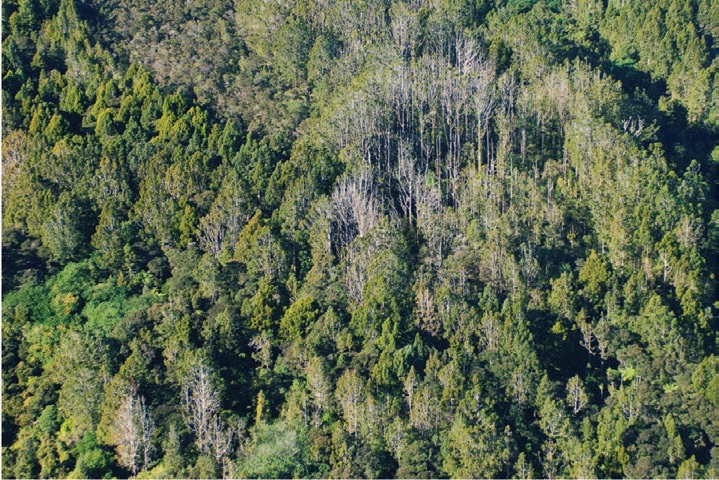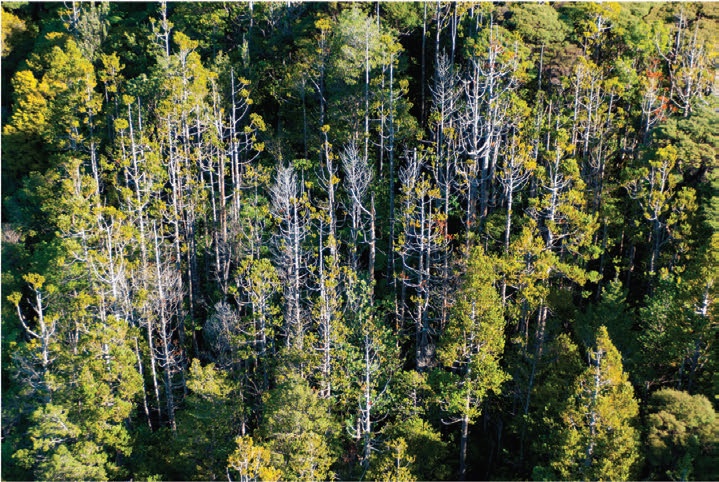Management of kauri dieback
Nick Waipara, New Zealand Tree Grower May 2013.
Our kauri is under threat from an emerging disease commonly referred to as kauri dieback. It has already killed thousands of kauri trees and will spread further unless all forest users take action.
The iconic kauri forests of northern New Zealand are an important and unique ecosystem. Kauri contributes to our national identity, economic prosperity from tourism, and our overall biodiversity and interconnected forest ecosystems. In 2008, new research revealed kauri dieback to be a major and potentially catastrophic threat to kauri. It was declared as an unwanted organism, or pest, under the Biosecurity Act.
What is kauri dieback?
Kauri dieback is caused by a mysterious fungus-like pathogen called Phytophthora taxon Agathis (PTA), which so far has only been shown to infect New Zealand kauri and can kill trees of all ages. Microscopic spores in the soil infect kauri roots and damage the conductive tissues which carry nutrients within the tree. Phytophthoras are commonly known as water moulds and are some of the most destructive plant diseases known.
Infected trees show a range of symptoms including yellowing of foliage, loss of leaves, canopy thinning, dead branches and lesions that bleed resin at the base of the trunk. It is thought the infection has been introduced from overseas and research is under way to determine the origins of the pathogen. The disease produces both a soil-borne oospore and a water-borne motile zoospore, both of which can infect kauri roots.
One of the few positive aspects is that the disease so far only affects kauri. Other woody plants and trees such as radiata pine, oak, pohutukawa and manuka have been tested, with none succumbing to the pathogen. However, experimental testing of other important plant species is still under way at Landcare Research to fully assess the risk to the New Zealand forest and wider environment.


Spreading problems
The horticultural and commercial forestry sectors in this country have long known about the perils of Phytophthora diseases on their crops and nurseries. For example, Phytophthora cinnamomi is still a major pest in radiata pine nurseries, plantings and plantations. Kauri dieback is also known to cause similar problems for people trying to propagate and plant kauri for ornamental or restoration reasons. The disease has already been confirmed in several kauri plantations in Northland and Great Barrier Island.
Unfortunately it has spread into the natural kauri forest parks and is killing trees across the Waitakere Ranges, on private land and reserves throughout the Auckland region, Department of Conservation reserves at Okura, Albany, Great Barrier Island, Trounson Kauri Park and the Waipoua Forest in Northland, home of our most iconic kauri Tane Mahuta.
Protection needed
However, there are still many pockets of healthy kauri and resilience. At this stage, the disease has not been detected in many areas of Northland forest, the Hunua Ranges, Waikato and the Coromandel peninsula. It is now urgent and imperative that we protect these unaffected areas.
One of the major initiatives in place to ensure this protection of healthy trees is track closures to form kauri protection zones at some regional parks, including the Waitakere Ranges and Hunua Ranges regional parks. Protection zones have been created in areas where PTA has not yet been detected and trees are still healthy. In 2012, the Department of Conservation also closed access to Mataitai Reserve in Hunua for five years to protect the healthy 800-year-old kauri trees in the forest. Work is also going on across kauri land to improve track construction, drainage and other man-made influences which will help reduce the spread of the disease.
The biosecurity programme has focused on limiting the spread of the disease and protecting uninfected locations. Information is being shared with landowners, farmers, visitors, community groups, tramping clubs and event managers to help build awareness, understanding and action around kauri dieback.
Response and research
The Ministry for Primary Industries, the Department of Conservation, Auckland Council, Northland Regional Council, Waikato Regional Council, Bay of Plenty Regional Council and Maori have joined forces to cover research into the detection and spread of kauri dieback, methods to control it, and public awareness campaigns to help stop its spread. A surveillance programme is currently under way to assess and monitor locations of kauri dieback disease. All landowners with kauri on their properties are being urged to monitor their trees for any signs of ill health and get in touch if they notice any of the symptoms of kauri dieback or signs of decline. Anyone propagating kauri in nurseries noticing a sudden or unusual death of their seedlings and saplings should call the 0800 number at the end of this article.
As kauri dieback is a generally unknown organism, research is required to improve detection methods, increase our knowledge of how the disease spreads and develop effective control methods. Plant & Food Research are now undertaking field trials involving the use of phosphite to treat the disease. Landowners and commercial industry partners have also begun testing soil health inoculants and beneficial products to try and fight the disease in the roots and soil. However, further work is urgently required to complete these trials.
Can infected trees be harvested?
Dead and dying kauri are increasingly being reported by the public as the disease continues to spread. Thousands of trees have already been killed on private and public lands. As more succumb to the disease can the good quality kauri timber from dying and dead kauri be harvested?
At the moment the answer is no, the timber from dying or dead kauri cannot be harvested. Under current standard operating procedures for kauri tree removal and pruning, where any kauri timber needs to be removed from a site it must go to a landfill or be burned. The standard operating procedures also note that if a felled kauri does not need to be removed from a site, the felled log must be left in place. Such a precautionary approach has been taken because it is assumed that all of the kauri timber is infected by PTA, and there is
a biosecurity requirement to limit the spread of the kauri dieback disease to other sites from the felled timber.
However, a new research project is under way to find out exactly where exactly PTA is in the wood. As well as the distribution throughout the timber, samples from the upper branches, canopy, foliage, cones and seeds are being studied to see if the pathogen is present in a whole tree. This research will enable the current kauri tree removal and pruning procedures to be updated, and provide best practice guidelines for cultural harvest or safe disposal of kauri timber. Importantly, more will be understood about how to limit the spread of kauri dieback.
Message to forest owners
The main message to forest owners is that prevention is currently the only effective protection measure to stop the spread of the disease.
- Ensure shoes, tyres and equipment are cleaned to remove all visible soil and plant material before coming on to your property and near your kauri trees
- Minimise soil movement and disturbance around kauri tree roots
- Where possible fence off trees from livestock
- Seek advice when opening up kauri areas with new tracks or access points to trees
- Ask for advice and undertake hygiene measures when harvesting kauri trees − sustainable harvest permits for kauri are still administered by the Ministry for Primary Industries.
These protection messages have come from the understanding that spores of kauri dieback are found in the soil around affected kauri. Any movement of infected soil can spread the disease. Human activity involving soil movement on footwear, machinery or equipment is thought to be the greatest cause of spread. The soil-borne spores are also very hardy and can live for at least three years in the soil, which emphasises how important it is to clean footwear and equipment. When visiting kauri parks and reserves before and after visiting any kauri forest ensure your shoes and tyres are clean of soil. You can do this at a cleaning station if there is one on a park or reserve, or at home by simply scrubbing your gear clean of soil.
We all can help – forestry landowners, tourists, hunters, trappers, trampers, runners, bikers and walkers. To spread the word rather than the disease, you can access more information and progress updates at the programme’s website at www.kauridieback.co.nz. If you think your trees have symptoms of kauri dieback call 0800 NZ KAURI (69 52874).
Nick Waipara is Principal Advisor for Biosecurity at the Auckland Council.

 Farm Forestry New Zealand
Farm Forestry New Zealand